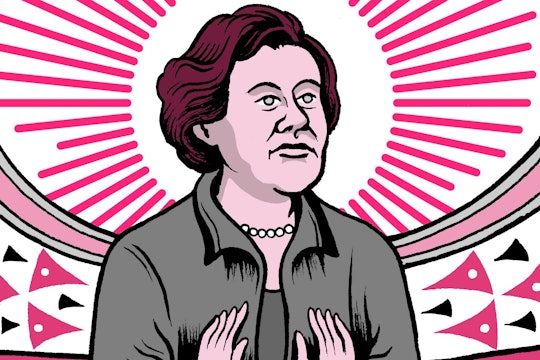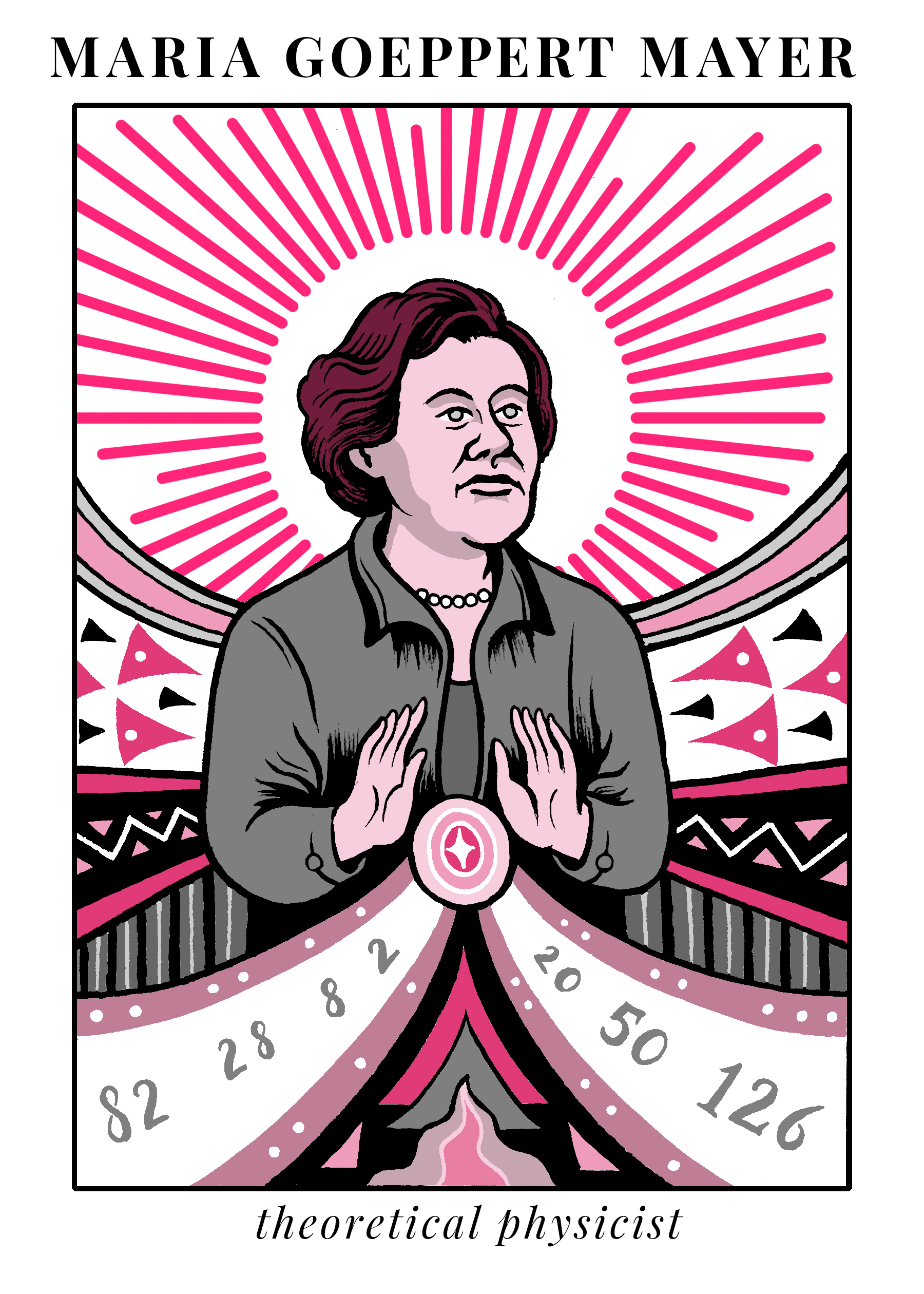
Matteo Farinella
Maria Goeppert Mayer discovered the magic numbers at the center of atoms
She didn't have a paid professorship until three years before her Nobel prize
Maria Goeppert Mayer was a German-American physicist who contributed discoveries to multiple scientific fields, despite spending most of her career without a faculty appointment.
Her doctorate research in theoretical physics at Göttingen University predicted two-photon absorption of molecules 30 years before lasers allowed for experimental validation. And after immigrating to the United States in 1930, she was the first scientist to propose the double beta decay of atoms and made the first calculation of how a complex organic molecule absorbs and emits energy.
Most famously, in 1963 Goeppert Mayer became only the second woman to receive the Nobel Prize in Physics - 60 years after Marie Curie. She received the prize for her discovery of Magic Numbers – the reason why certain configurations of protons and neutrons in the nucleus of an atom are more stable than others.
Goeppert Mayer was born in 1906 in Kattowitz, then a part of the German Empire (now Katowice, Poland) to Maria and Friedrich Goeppert, a sixth-generation university professor who specialized in pediatrics at Göttingen University. As their only child, she was close to her father and able to pursue an education, excelling at mathematics. But in the 1920s, there were no public schools in her region of Germany that would prepare girls for the abitur, the entrance exam for German universities.
She left public school in 1921 to enroll at a small private school run by suffragettes that would prepare her for the exam. Despite the abrupt closure of the school before she was able to complete its three year program, she took the entrance test a year early. She passed, and in 1924, Goeppert Mayer enrolled at Göttingen University as a Mathematics student.
While studying for her mathematics degree, Goeppert Mayer was invited to join a seminar in theoretical physics taught by Max Born, a future Nobel laureate. As a result, her interests shifted and she completed her doctorate in theoretical physics in 1930. Her examiners included three Nobel laureates: James Franck, Adolf Windaus, and Born.
Her thesis, described later as being a “masterpiece of clarity and concreteness,” dealt with the theoretical implications of two photon absorption by atoms. While at the time there was no way to test her predictions, the development of lasers in the 1960s permitted experimental validation of her theories and paved the way for applications in spectroscopy and sophisticated microscope imaging. The unit for the two-photon absorption cross section is named the "GM" to honor her contribution to the field.
The struggles of a woman in science
In 1930, Goeppert Mayer married a fellow physicist, Joseph Edward Mayer. The couple moved back to Mayer’s native United States, where he took a job as a professor at Johns Hopkins University in Baltimore, Maryland. But at the time, universities did not hire the wives of their professors due to "anti-nepotism" regulations, so there was no faculty position available for Goeppert Mayer. Nevertheless, she kept working as an assistant in the Physics department, who was able to arrange for her a small salary, a little bit of space, and access to the facilities. She was able to teach some graduate courses, and continued to collaborate with her mentor, Born, returning to Göttingen several times.
Even with such little support from Johns Hopkins, Goeppert Mayer continued to publish her important discoveries. In 1935, she published an important paper proposing the idea of double beta decay, a type of radioactivity that occurs when two protons are simultaneously transformed into two neutrons (or neutrons into protons) inside the nucleus of an atom, which then releases two beta particles. She followed this by publishing a paper in 1938 calculating the spectrum of benzene, where she predicted the frequencies at which this organic molecule would absorb and emit electromagnetic radiation.

Matteo Farinella
Despite her impressive credentials, her situation only worsened when her husband moved to Columbia University in New York City in 1939. There, the Physics department was only able to offer her a small office space, without any salary or other support. But while her academic position was a step backward, other things made life in New York a step forward for Goeppert Mayer - namely meeting Enrico Fermi and Harold C. Urey. Fermi in particular would be an influence on Goeppert Mayer's work, and he suggested that she use her skills to calculate the atomic structure of the transuranium elements. At the time, these elements were only theorized, and just beginning to be discovered by laboratory synthesis. She published these calculations in 1941, correctly predicting that the elements would form a new rare earth series.
Finally, Goeppert Mayer was offered a job in 1941 – teaching part-time at Sarah Lawrence College in Bronxville, New York. She continued to teach part-time throughout WWII and was offered a job by Urey with Columbia University's Substitute Alloy Materials (SAM) Project, which was separating uranium isotopes as part of the Manhattan Project. Her part of the project proved unsuccessful, which she later admitted she was relieved about.
After the war, the Mayers moved to Chicago, where she received a comparatively warm welcome at the University of Chicago. "Anti-nepotism" rules still existed, but she was allowed to be appointed as a professor in the Physics department in a voluntary position without a salary. Fermi and Urey also joined the University of Chicago, so she continued to have supportive collaborators. And at the same time, she was able to join Argonne National Laboratory as a paid researcher. It was at Argonne that she dove into a new field – nuclear physics – and soon made a major contribution.
In 1949, Goeppert Mayer published her most famous discovery. She had used her extensive background in mathematics to develop a model for the structure of nuclear shells, the arrangement of the protons and neutrons in the nucleus of an atom. Her model explained why certain numbers of protons or neutrons within an atomic nucleus made for particularly stable configurations. Eugene Wigner, a fellow physicist who would share the Nobel with Goeppert Mayer, dubbed these configurations magic numbers.
What exactly made these configurations magical came to Goeppert Mayer during a conversation with Fermi. As he left the room for a phone call, he offhandedly asked her about how the particles in the nucleus might move. When he returned 10 minutes later she had an answer for him: the magic numbers were the result of the spin-orbit couplings of the protons and neutrons in the nucleus. To simplify, she would describe her discovery using a metaphor: “Everyone who has ever danced a fast waltz knows that it’s much easier if all the couples are dancing in one direction.”
Goeppert Mayer also shared the Nobel Prize with J. Hans Jensen, a German scientist who arrived simultaneously at the same conclusion. The two later collaborated, and together wrote a book on the subject of nuclear shells in 1955.
Goeppert Mayer was finally appointed as a full professor of Physics at the University of California, San Diego in 1960. In 1963, she was awarded the Nobel Prize in Physics, after receiving 27 nominations dating back to 1955. Sixty years after Marie Curie, Goeppert Mayer was just the second woman to win in the Physics category - a feat that would not be repeated until 55 years later, when Canadian physicist Donna Strickland won the prize in 2018.
Shortly after her arrival in San Diego, Goeppert Mayer suffered her first stroke, leading to years of health problems. She continued to teach and research, contributing to ongoing elaboration of the nuclear shell model. Her final publication was a book chapter written with her collaborator and co-Nobel laureate Jensen in 1965. Goeppert Mayer died following a decade of declining health in 1972. In 1985, the American Physical Society named an award in her honor, to recognize outstanding female physicists.
